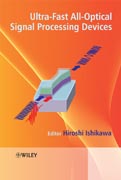
A thorough and in-depth treatment of the state-of-the-art development of semiconductor based ultrafast all-optical devices; this book provides practical examples to clearly explain the technologies. It also explains technical issues in turning the ultrafast optical devices into practical working tools. INDICE: Chapter 1: Introduction. 1.1 Evolution of optical communication systems and device technologies. 1.2 Increasing communication traffics and powerconsumption. 1.3 Future networks and technologies. 1.3.2 Future networks. 1.3.2 Schemes for huge capacity transmission. 1.4 Ultrafast all-optical signal processing devices. 1.4.1 Challenges. 1.4.2 Basics of nonlinear optical process.1.5 Overview of the devices and their concepts. 1.6 Summary. Chapter 2: LightSources. 2.1 Requirement for light sources. 2.1.1 Optical short pulse source . 2.1.2 Optical time division multiplexer. 2.2 Mode-locked laser diodes. 2.2.1Active mode-locking. 2.2.2 Passive mode-locking. 2.2.3 Hybrid mode-locking. 2.3.4 Optical synchronous mode-locking. 2.3.5 Application for clock extraction.2.3 Electro-absorption modulator (EAM) based signal source. 2.3.1 Overview ofelectro-absorption modulator. 2.3.2 Optical short pulse generation using EAM.2.3.3.Optical time division multiplexer based on EAM. 2.3.4 160-Gb/s optical signal generation. 2.3.5 Detection of 160-Gb/s OTDM signal. 2.3.6 Transmissionissues. 2.4 Summary. Chapter 3: Semiconductor optical amplifier based ultrafast signal processing devices. 3.1 Introduction. 3.2 Fundamental of SOA. 3.3 SOA as an ultrafast nonlinear medium. 3.4 Use of ultrafast response component byfiltering. 3.4.1 Theoretical background. 3.4.2 Signal processing using fast response component of SOA. 3.5 Symmetric Mach-Zehnder (SMZ) all-optical gate. 3.5.1 Fundamentals of the SMZ all-optical gate. 3.5.2 Technology of integratingoptical circuits for SMZ all-optical gate. 3.5.3 Optical demultiplexing. 3.5.4 Wavelength conversion and signal regeneration. 3.6 Summary. Chapter 4: Uni-traveling-carrier photodiode (UTC-PD) and PD-EAM optical gate integrating a UTC-PD and a traveling wave electro-absorption modulator. 4.1 Introduction. 4.2 Uni-traveling-carrier photodiode (UTC-PD). 4.2.1 Operation. 4.2.2 Fabrication and characterization. 4.2.3 Characteristics of the UTC-PD. 4.2.4 Photoreceivers. 4.3 Concept of new opto-electronic integrated device. 4.3.1 Importance of high-output PDs. 4.3.2 Monolithic digital OEIC. 4.3.3 Monolithic PD-EAM optical gate. 4.4 PD-EAM optical gate integrating UTC-PD and TW-EAM. 4.4.1 Basic structure. 4.4.2 Design. 4.4.3 Optical gating characteristics of PD-EAM. 4.4.4 Fabrication. 4.4.5 Gating characteristics. 4.4.6 Applications for ultrafast all-optical signal processing. 4.4.7 Future work. 4.5 Summary and prospects. Chapter5: Intersubband transition all-optical gates. 5.1 Operation principle. 5.1.1 Transition wavelength. 5.1.2 Matrix element. 5.1.3 Saturable absorption. 5.1.4Absorption recovery time. 5.1.5 Dephasing time and spectral linewidth. 5.1.6 Gate operation in waveguide structure. 5.2 GaN/AlN ISBT gate. 5.2.1 Absorptionspectra. 5.2.2 Saturation of absorption in waveguide. 5.2.3 Ultrafast opticalgate. 5.3 (CdS/ZnSe)/BeTe ISBT gate. 5.3.1 Growth of CdS/ZnSe/BeTe QWs and ISBT absorption spectra. 5.3.2 Waveguide structure for CdS/ZnSe/BeTe gate. 5.3.3Characteristics of CdS/ZnSe/BeTe gate. 5.4 InGaAs/AlAs/AlAsSb ISBT gate. 5.4.1 Device structure and its fabrication. 5.4.2 Saturation characteristics and time response. 5.5 Cross-phase modulation effect in InGaAs/AlAs/AlAsSb ISBT gate. 5.5.1 Cross-phase modulation effect and its mechanisms . 5.5.2 Application to wavelength conversion. 5.6 Summary. Chapter 6: Wavelength conversion devices. 6.1 Introduction. 6.2 Wavelength conversion schemes. 6.2.1 Optical gate switch type. 6.2.1 Coherent type conversion. 6.3 Physics of four-wave mixing in LDs and SOAs. 6.3.1 Model. 6.3.2 Asymmetric for positive and negative detuning.6.3.3 Symmetric in quantum dot SOAs. 6.4 Wavelength conversion of short pulses using FWM in semiconductor devices. 6.4.1 Model. 6.4.2 The effect of the stopband in DFB-LDs. 6.4.3 The effect of the depletion of gain. 6.4.4 The pulse width broadening in FWM wavelength conversion. 6.5 Experimental results of wavelength conversion using FWM in SOAs and LDs. 6.5.1 Wavelength conversion of short pulses using a DFB-LD. 6.5.2 Wavelength conversion of 160Gb/s OTDM signal using a quantum dot SOAs. 6.5.3 Format free wavelength conversion. 6.5.4 Chromatic dispersion compensation of optical fiber using FWM in DFB-LDs. 6.6 The future view of wavelength conversion using FWM. 6.7 Summary. Chapter 7: Summary and future prospects. 7.1 Introduction. 7.2 Transmission experiments. 7.2.1 FESTA experiments. 7.2.2 A test bed field experiment. 7.2.3 Recent above 160Gb/stransmission experiments. 7.3 Requirements on devices and prospects. 7.3.1 Devices described in this book. 7.3.2 Necessity of new functionality devices andtechnology. 7.4 Summary and future prospects.
- ISBN: 978-0-470-51820-5
- Editorial: John Wiley & Sons
- Encuadernacion: Cartoné
- Páginas: 304
- Fecha Publicación: 01/08/2008
- Nº Volúmenes: 1
- Idioma: Inglés
